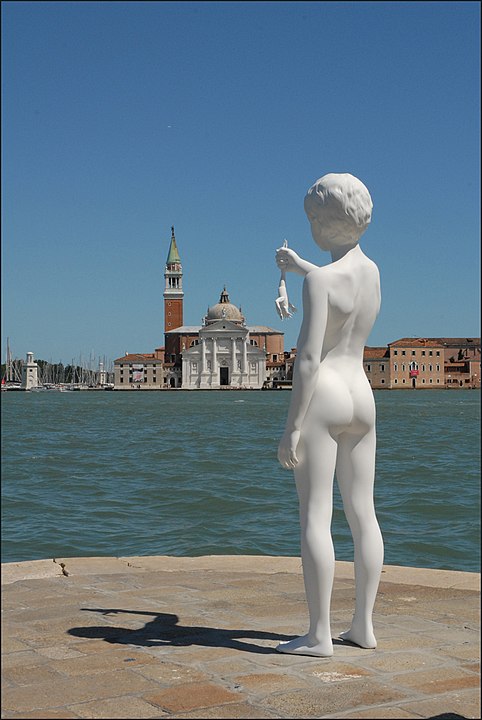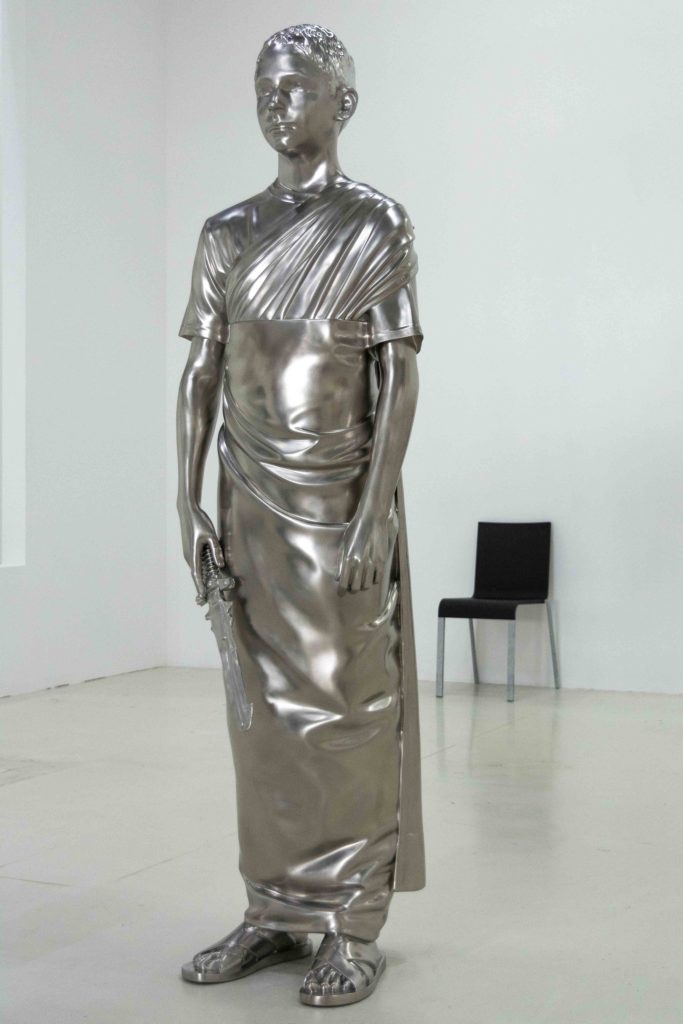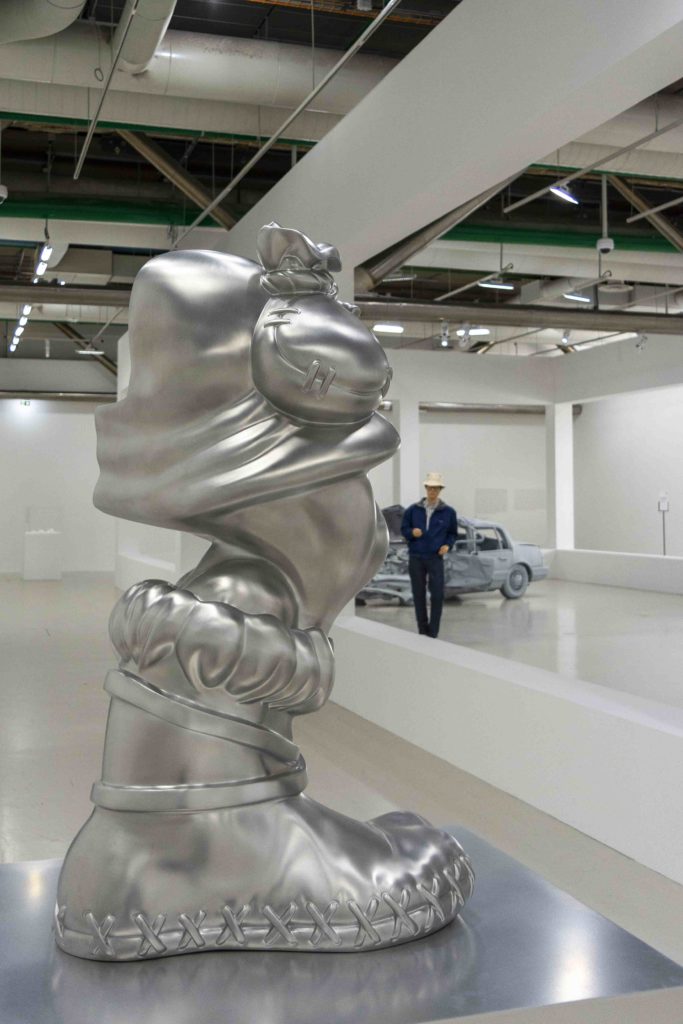The Sculptor Charles Ray .
“My sculptures don’t represent anybody or anything. They’re not depictions.”
Charles Ray.
Do you have an exhibition buddy ?
I am fortunate in that I have several, one of them being my husband. He trained as an engineer and is rather Cartesian, that is to say that he leans towards what is rational and logical. But he is also wonderfully curious about the world and happily comes to see all sorts of exhibitions with me.
This summer we visited three exhibitions. The first was a retrospective of the American sculptor Charles Ray.

Charles Ray’s Early Life.
Sculptor Charles Ray is a major figure in contemporary American art. He was born in Chicago in 1953 and currently lives and works in Los Angeles. The exhibition at the Centre Pompidou in Paris, was the first in a French public institution.
His parents owned and ran a commercial art school, which his grandmother had founded in 1916. He was the second oldest in his family and has four brothers and a sister.
On Saturdays he went to the Illinois Art Institute’s studio program for high-school students. Then earned his BFA at the University of Iowa and his MFA from at Rutgers University.

Learning Modern Sculpture Processes.
At the University of Iowa School of Art and Art History with Roland Brener, who exposed Ray to many of developments of Modernist sculpture, in particular the constructivist aesthetic of artists like Anthony Caro and David Smith.
Constructivist art aimed to reflect modern industrial society and urban space. The movement rejected decorative stylisation in favour of the industrial assemblage of materials.
“The formal rules as taught by Brener were a kind of nourishment for me. The actual working in the studio was, in a sense, the expression. I was taught that the finished sculpture was maybe the end of the paragraph. Once a sculpture was completed it was critiqued and put back on to the scrap pile. This way of working taught me to think sculpturally rather than to think about sculpture.”
Charles Ray Retrospective.
The sculptor’s works, while few in number around one hundred to date, is extremely rich.
It asks the viewer: “What qualifies as sculpture?”
Charles Ray’s work is difficult to classify as the style, materials, subject and scale are all variable. His work is influenced by an in-depth knowledge of the history of sculptural art, from ancient Greek sculptures to the creations of some of his contemporaries. Although, it clearly draws from a minimalist focus on material.
With approximately 30 pieces on show in Paris, in two venues, depicting humans, plants and vehicles in his favoured materials of wood and metal, the exhibition explored the artist’s relationship with Minimalism and the uncompromising perfectionism apparent in his work.

For Unpainted Sculpture (1997), over the course of two years, Ray reconstructed a life-sized crashed Pontiac Grand Am (circa 1991) out of fibreglass, casting and assembling each piece to match the bent and twisted forms of the original. Despite the work’s title, it is painted a soft dove grey that is reminiscent of the plastic parts of model car kits.
His sculptures, Ray likes to say, all start somewhere, but they don’t stay there. Unpainted Sculpture isn’t about the death of the car’s driver, just as it isn’t about the history of Pontiac car production in Detroit. For Charles Ray the process of creating is more important than the finished object.
Size Matters.

Many of Charles Ray’s works are either tiny or oversized.
Why ?
For years, Ray struggled with his life-sized sculpture of the addict Jeff seated dejectedly on a box. One day he identified the problem.
“Your empathy just over-ran the object, your pity enveloped it. The sculpture had no relationship to you; you only had a relationship to the sculpture.”
As a consequence, the sculpture “remained a depiction; it remained a portrait’”.
By scaling up the figure by about 50 per cent, he found, ‘the sculpture could fight back’ and the portrait of Jeff became a sculpture by Ray.
Ray, who once worked as a department store janitor, created sculptures of mannequins. Fall ’91 (1992), above, is a fibreglass female dressed in a power suit. She has the features of a conventional mannequin, from the body proportions to the blank look in her eyes. The only thing Ray modified was the scale – she is a towering 2.44m tall.
A Life Of Their Own.
Ray says, “my sculptures don’t represent anybody or anything. They’re not depictions.”
He often talks about his sculpture as having its own soul and life and wanting to create things with pneuma, Greek for “breath of life” or “spirit”.

Portrait of the Artist’s Mother (2021), a large masturbating female nude, also made from paper, is definitely not Ray’s mother.
His most labor-intensive work to date is the ten-year re-creation in Japanese cypress (Hinoki) of a fallen and rotting tree he had found in a meadow.

With Hinoki (2007, Art Institute of Chicago), Ray had a mould made of a large rotting tree he found in California. He then hired a team of Japanese woodcarvers in Osaka to essentially re-carve the tree in Hinoki, a different wood than that of the original tree.

Hinoki is a type of Japanese cypress wood that has long been used in Japan for its beauty, durability, and delicate, natural fragrance. It is a traditional Japanese building material and was often used in temples and shrines.
In an interview with Michael Fried, Ray made it clear that the purpose of the piece was not to carve an exact replica of the tree ….
“The tree had that beautiful interior that fallen logs have,” he says. “It happens when bugs eat out the hard wood, so you have this hollow thing. All I knew was that I wanted to carve that, I wanted people to have a sense of that interior [of the log] because it’s in there, even if normally it couldn’t be seen. So that was really important. I wanted to make it matter to you.”

Another iconic sculpture that plays with size and scale is Family Romance (1993) – father, mother, son and daughter, all naked, all holding hands, and all 1.35m in height. It is a disturbing work, and Freudian interpretations abound, but the artist finds the meaning in the space where their hands meet.
Inspiration From Past Masters.

In 2009, Ray installed Boy with Frog, his first outdoor commissioned work, at the Punta della Dogana, Venice. Grand in size and realised with a smooth white finish that references the important tradition of marble sculpture in Italy, it depicted a nine years old boy holding a Goliath frog above the Grand Canal. The statue was removed in 2013 and replaced with a lamp-post that had previously occupied the site.
The sculpture references the Apollo Sauroktonos, an ancient Roman sculpture at the Musée du Louvre, in Paris. It is of a nude adolescent reaching out his arm to catch a lizard climbing a tree. It also brings to mind the Boy with Thorn (Lo Spinario), a bronze statue at the Musei Capitolini, of a seated Roman boy plucking a thorn from the sole of his foot.





The level of historical reference behind the sculptor Charles Ray’s works has led many critics to call him a sculptor’s sculptor. Nevertheless, his art has managed to find a large audience, thanks to its striking and beguiling nature.
Whether recreating fallen trees down to every nook and cranny or conjuring a certain vulnerability in his life-size steel figures, Ray’s pieces are characterised by an intricacy that lends an almost uncanny realism to his sculptures in spite of their sometimes unusual scale. With his meticulous attention to detail, Ray invites us to examine his sculptures with similar intensity and I found the human figures particularly captivating in their realism and therefore bizarre immobility.

Follow this link if you would like to read more about Charles Ray and the twin exhibition at the François Pinault Collection, housed in the renovated Paris Bourse de Commerce building, former location of the Stock Exchange: Charles Ray.

Take Care,
Henrie
XO.
